Influencing Organisational Strategy: A Case Study of Harley Davidson
VerifiedAdded on 2023/06/11
|12
|3633
|75
Case Study
AI Summary
This case study provides an in-depth analysis of Harley Davidson's organizational strategy, exploring the resources and capabilities that contribute to its competitive position within the motorcycle industry. It utilizes Porter's Five Forces to assess the external competitive landscape, examining internal rivalries, potential entrants, substitutes, and the bargaining power of both suppliers and buyers. The study also includes a SWOT analysis to identify Harley Davidson's strengths, weaknesses, opportunities, and threats. A comparison with leading motorcycle companies like Honda highlights areas of competitive advantage and disadvantage. The analysis emphasizes the importance of innovation, brand reputation, and strategic adaptation for sustained success in the global market. Desklib offers this case study and many other resources to support students in their academic endeavors.
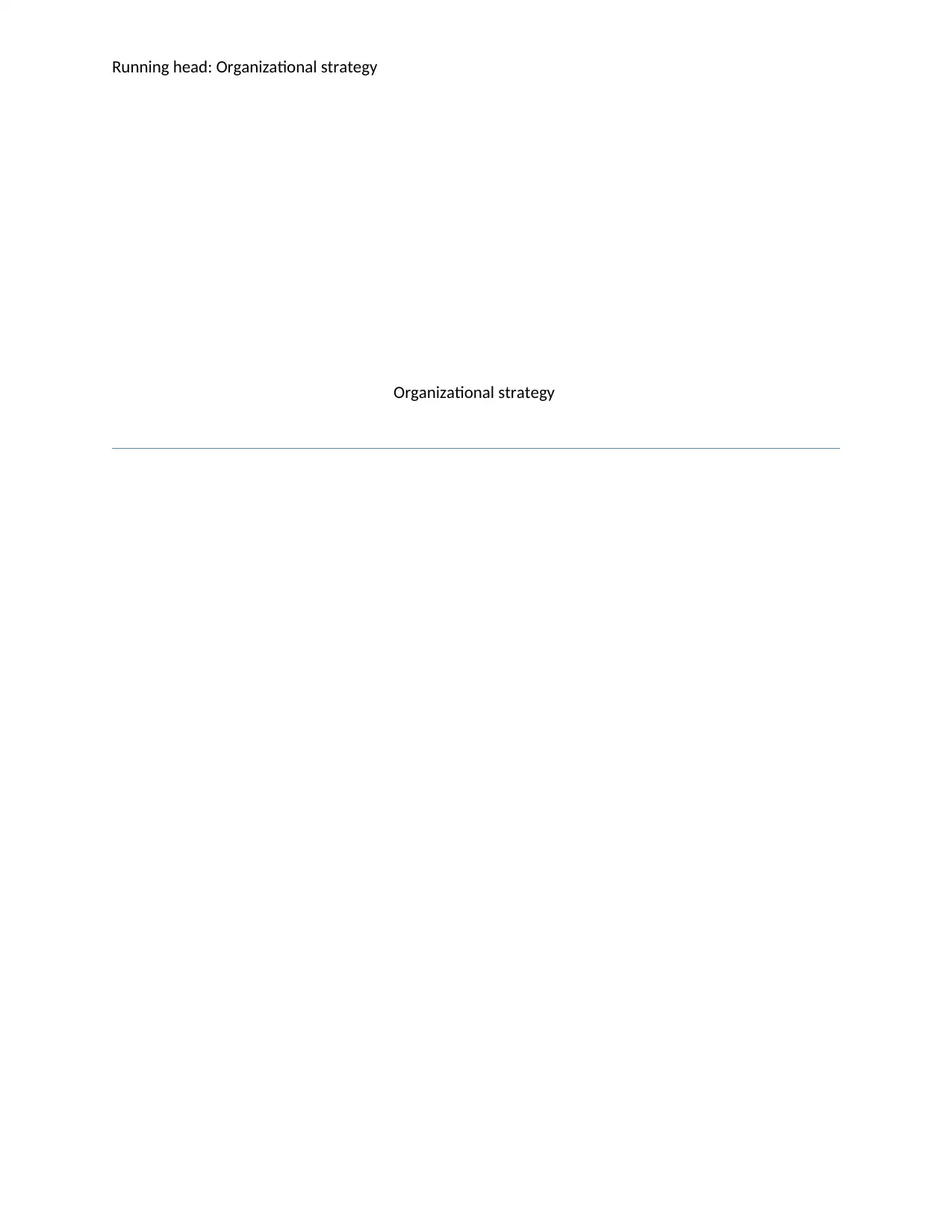
Running head: Organizational strategy
Organizational strategy
Organizational strategy
Paraphrase This Document
Need a fresh take? Get an instant paraphrase of this document with our AI Paraphraser
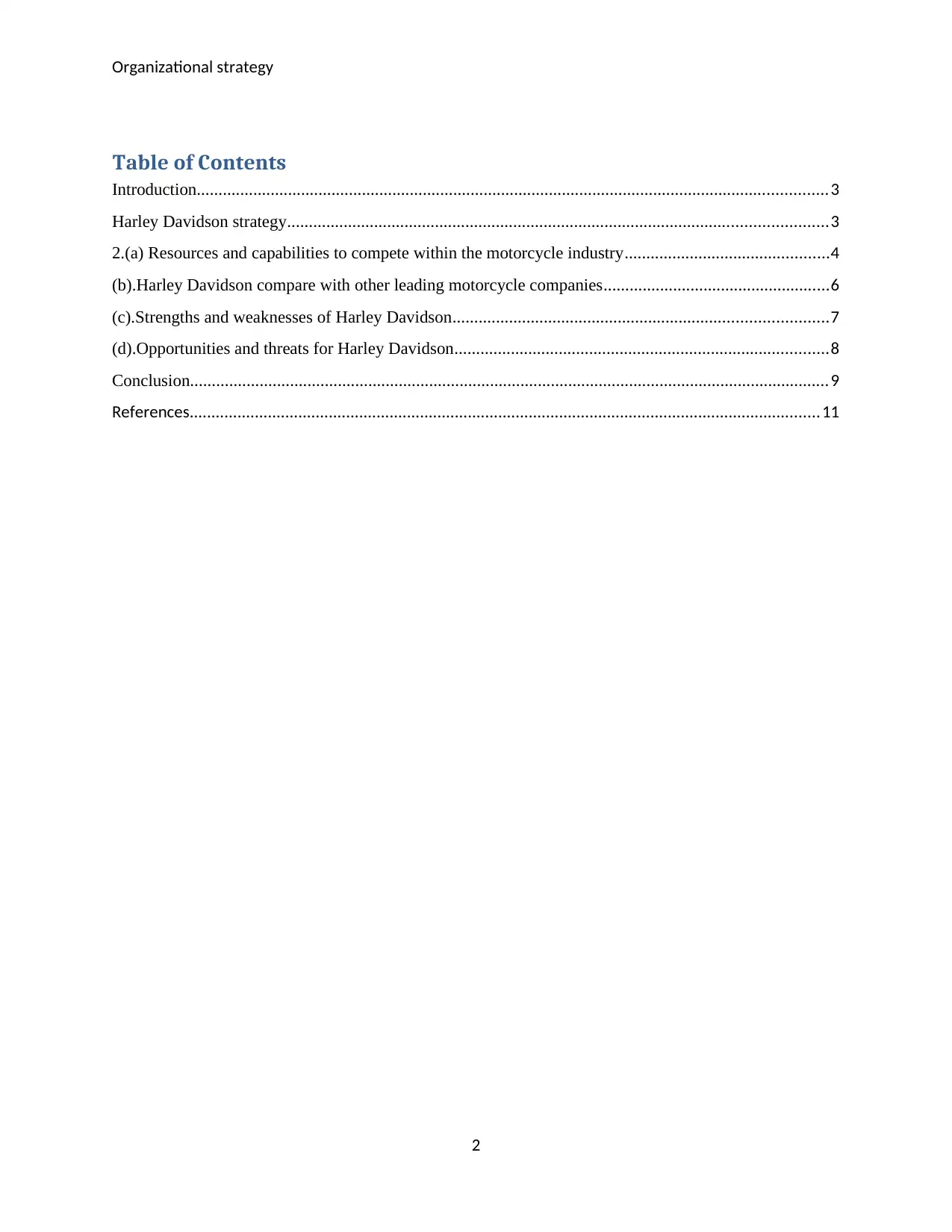
Organizational strategy
Table of Contents
Introduction.................................................................................................................................................3
Harley Davidson strategy............................................................................................................................3
2.(a) Resources and capabilities to compete within the motorcycle industry...............................................4
(b).Harley Davidson compare with other leading motorcycle companies....................................................6
(c).Strengths and weaknesses of Harley Davidson......................................................................................7
(d).Opportunities and threats for Harley Davidson......................................................................................8
Conclusion...................................................................................................................................................9
References.................................................................................................................................................11
2
Table of Contents
Introduction.................................................................................................................................................3
Harley Davidson strategy............................................................................................................................3
2.(a) Resources and capabilities to compete within the motorcycle industry...............................................4
(b).Harley Davidson compare with other leading motorcycle companies....................................................6
(c).Strengths and weaknesses of Harley Davidson......................................................................................7
(d).Opportunities and threats for Harley Davidson......................................................................................8
Conclusion...................................................................................................................................................9
References.................................................................................................................................................11
2
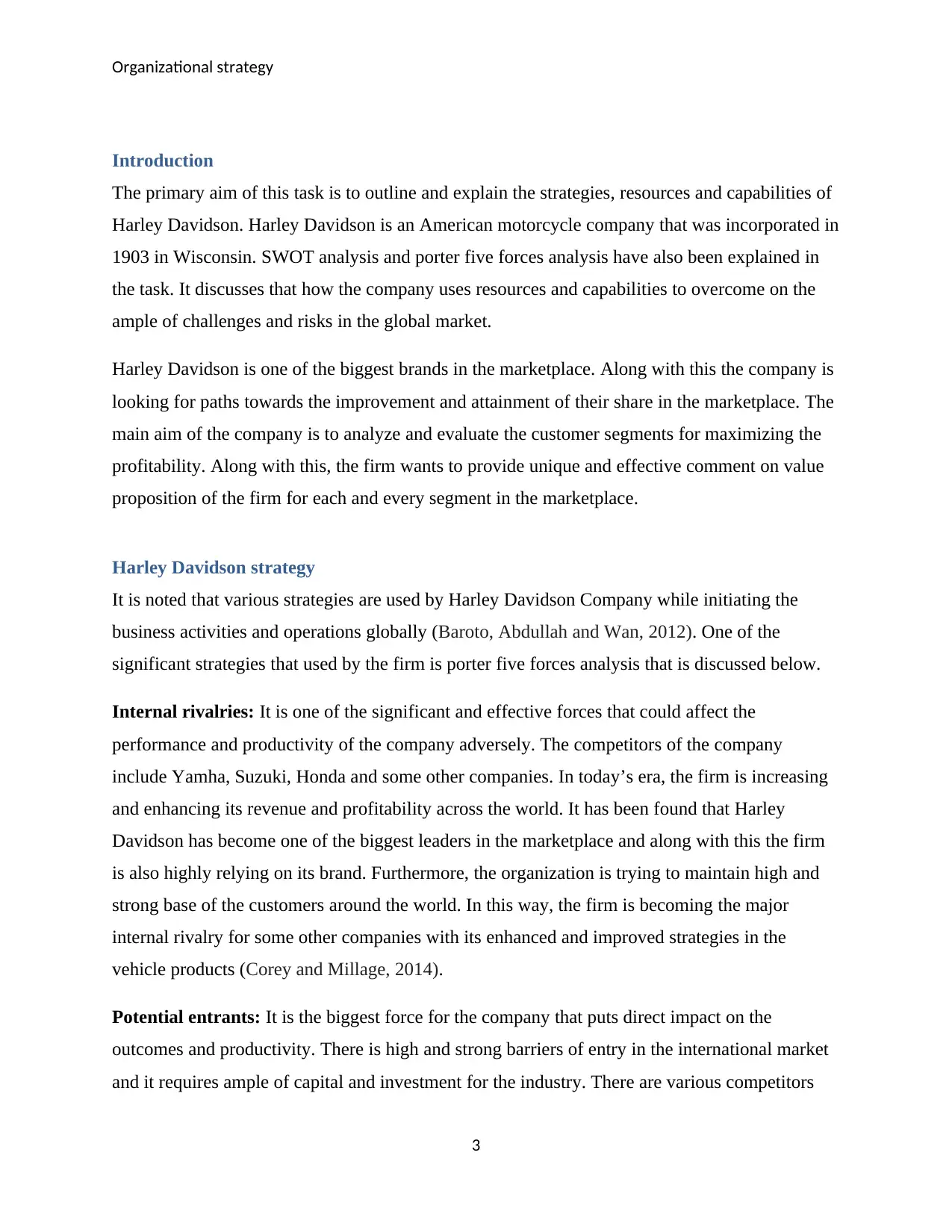
Organizational strategy
Introduction
The primary aim of this task is to outline and explain the strategies, resources and capabilities of
Harley Davidson. Harley Davidson is an American motorcycle company that was incorporated in
1903 in Wisconsin. SWOT analysis and porter five forces analysis have also been explained in
the task. It discusses that how the company uses resources and capabilities to overcome on the
ample of challenges and risks in the global market.
Harley Davidson is one of the biggest brands in the marketplace. Along with this the company is
looking for paths towards the improvement and attainment of their share in the marketplace. The
main aim of the company is to analyze and evaluate the customer segments for maximizing the
profitability. Along with this, the firm wants to provide unique and effective comment on value
proposition of the firm for each and every segment in the marketplace.
Harley Davidson strategy
It is noted that various strategies are used by Harley Davidson Company while initiating the
business activities and operations globally (Baroto, Abdullah and Wan, 2012). One of the
significant strategies that used by the firm is porter five forces analysis that is discussed below.
Internal rivalries: It is one of the significant and effective forces that could affect the
performance and productivity of the company adversely. The competitors of the company
include Yamha, Suzuki, Honda and some other companies. In today’s era, the firm is increasing
and enhancing its revenue and profitability across the world. It has been found that Harley
Davidson has become one of the biggest leaders in the marketplace and along with this the firm
is also highly relying on its brand. Furthermore, the organization is trying to maintain high and
strong base of the customers around the world. In this way, the firm is becoming the major
internal rivalry for some other companies with its enhanced and improved strategies in the
vehicle products (Corey and Millage, 2014).
Potential entrants: It is the biggest force for the company that puts direct impact on the
outcomes and productivity. There is high and strong barriers of entry in the international market
and it requires ample of capital and investment for the industry. There are various competitors
3
Introduction
The primary aim of this task is to outline and explain the strategies, resources and capabilities of
Harley Davidson. Harley Davidson is an American motorcycle company that was incorporated in
1903 in Wisconsin. SWOT analysis and porter five forces analysis have also been explained in
the task. It discusses that how the company uses resources and capabilities to overcome on the
ample of challenges and risks in the global market.
Harley Davidson is one of the biggest brands in the marketplace. Along with this the company is
looking for paths towards the improvement and attainment of their share in the marketplace. The
main aim of the company is to analyze and evaluate the customer segments for maximizing the
profitability. Along with this, the firm wants to provide unique and effective comment on value
proposition of the firm for each and every segment in the marketplace.
Harley Davidson strategy
It is noted that various strategies are used by Harley Davidson Company while initiating the
business activities and operations globally (Baroto, Abdullah and Wan, 2012). One of the
significant strategies that used by the firm is porter five forces analysis that is discussed below.
Internal rivalries: It is one of the significant and effective forces that could affect the
performance and productivity of the company adversely. The competitors of the company
include Yamha, Suzuki, Honda and some other companies. In today’s era, the firm is increasing
and enhancing its revenue and profitability across the world. It has been found that Harley
Davidson has become one of the biggest leaders in the marketplace and along with this the firm
is also highly relying on its brand. Furthermore, the organization is trying to maintain high and
strong base of the customers around the world. In this way, the firm is becoming the major
internal rivalry for some other companies with its enhanced and improved strategies in the
vehicle products (Corey and Millage, 2014).
Potential entrants: It is the biggest force for the company that puts direct impact on the
outcomes and productivity. There is high and strong barriers of entry in the international market
and it requires ample of capital and investment for the industry. There are various competitors
3
⊘ This is a preview!⊘
Do you want full access?
Subscribe today to unlock all pages.

Trusted by 1+ million students worldwide
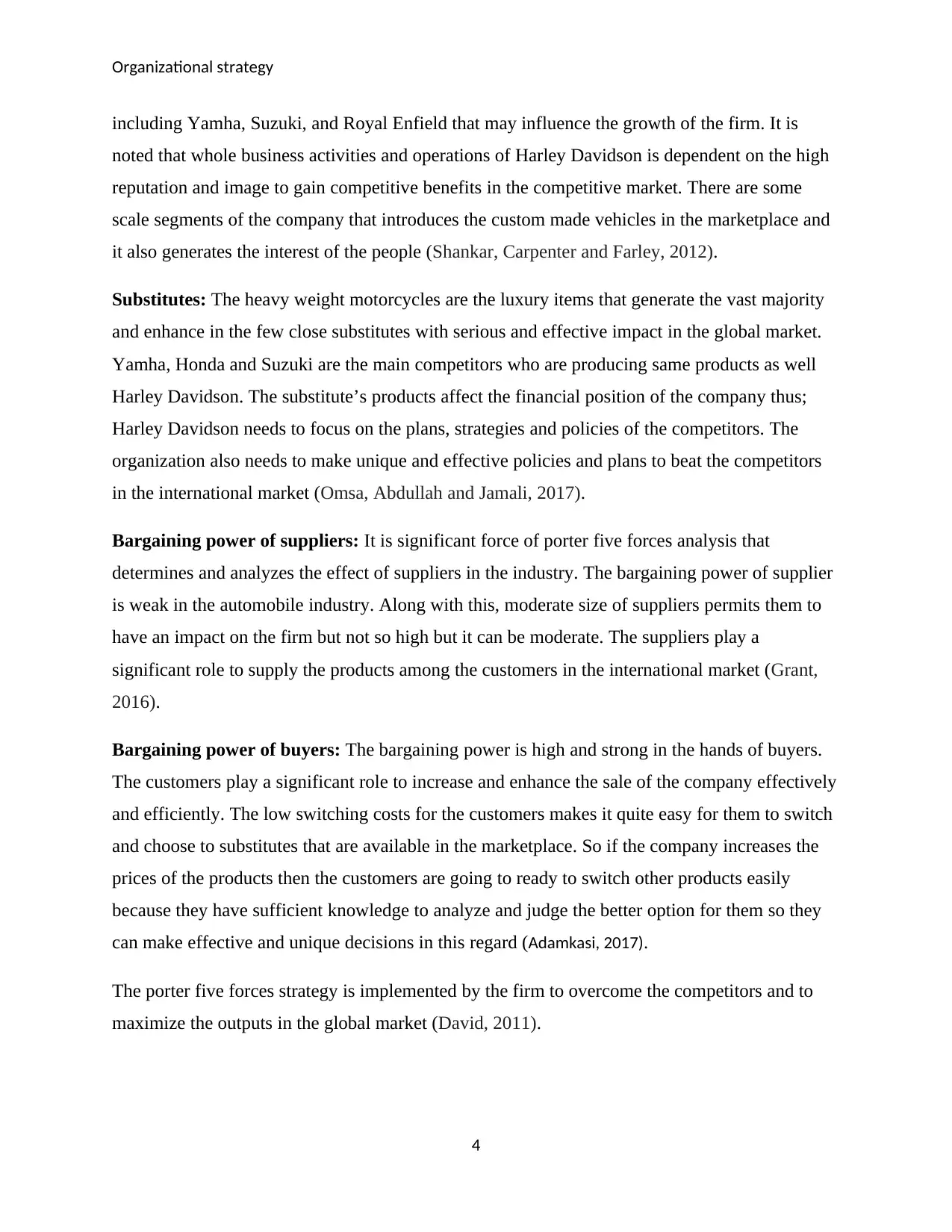
Organizational strategy
including Yamha, Suzuki, and Royal Enfield that may influence the growth of the firm. It is
noted that whole business activities and operations of Harley Davidson is dependent on the high
reputation and image to gain competitive benefits in the competitive market. There are some
scale segments of the company that introduces the custom made vehicles in the marketplace and
it also generates the interest of the people (Shankar, Carpenter and Farley, 2012).
Substitutes: The heavy weight motorcycles are the luxury items that generate the vast majority
and enhance in the few close substitutes with serious and effective impact in the global market.
Yamha, Honda and Suzuki are the main competitors who are producing same products as well
Harley Davidson. The substitute’s products affect the financial position of the company thus;
Harley Davidson needs to focus on the plans, strategies and policies of the competitors. The
organization also needs to make unique and effective policies and plans to beat the competitors
in the international market (Omsa, Abdullah and Jamali, 2017).
Bargaining power of suppliers: It is significant force of porter five forces analysis that
determines and analyzes the effect of suppliers in the industry. The bargaining power of supplier
is weak in the automobile industry. Along with this, moderate size of suppliers permits them to
have an impact on the firm but not so high but it can be moderate. The suppliers play a
significant role to supply the products among the customers in the international market (Grant,
2016).
Bargaining power of buyers: The bargaining power is high and strong in the hands of buyers.
The customers play a significant role to increase and enhance the sale of the company effectively
and efficiently. The low switching costs for the customers makes it quite easy for them to switch
and choose to substitutes that are available in the marketplace. So if the company increases the
prices of the products then the customers are going to ready to switch other products easily
because they have sufficient knowledge to analyze and judge the better option for them so they
can make effective and unique decisions in this regard (Adamkasi, 2017).
The porter five forces strategy is implemented by the firm to overcome the competitors and to
maximize the outputs in the global market (David, 2011).
4
including Yamha, Suzuki, and Royal Enfield that may influence the growth of the firm. It is
noted that whole business activities and operations of Harley Davidson is dependent on the high
reputation and image to gain competitive benefits in the competitive market. There are some
scale segments of the company that introduces the custom made vehicles in the marketplace and
it also generates the interest of the people (Shankar, Carpenter and Farley, 2012).
Substitutes: The heavy weight motorcycles are the luxury items that generate the vast majority
and enhance in the few close substitutes with serious and effective impact in the global market.
Yamha, Honda and Suzuki are the main competitors who are producing same products as well
Harley Davidson. The substitute’s products affect the financial position of the company thus;
Harley Davidson needs to focus on the plans, strategies and policies of the competitors. The
organization also needs to make unique and effective policies and plans to beat the competitors
in the international market (Omsa, Abdullah and Jamali, 2017).
Bargaining power of suppliers: It is significant force of porter five forces analysis that
determines and analyzes the effect of suppliers in the industry. The bargaining power of supplier
is weak in the automobile industry. Along with this, moderate size of suppliers permits them to
have an impact on the firm but not so high but it can be moderate. The suppliers play a
significant role to supply the products among the customers in the international market (Grant,
2016).
Bargaining power of buyers: The bargaining power is high and strong in the hands of buyers.
The customers play a significant role to increase and enhance the sale of the company effectively
and efficiently. The low switching costs for the customers makes it quite easy for them to switch
and choose to substitutes that are available in the marketplace. So if the company increases the
prices of the products then the customers are going to ready to switch other products easily
because they have sufficient knowledge to analyze and judge the better option for them so they
can make effective and unique decisions in this regard (Adamkasi, 2017).
The porter five forces strategy is implemented by the firm to overcome the competitors and to
maximize the outputs in the global market (David, 2011).
4
Paraphrase This Document
Need a fresh take? Get an instant paraphrase of this document with our AI Paraphraser
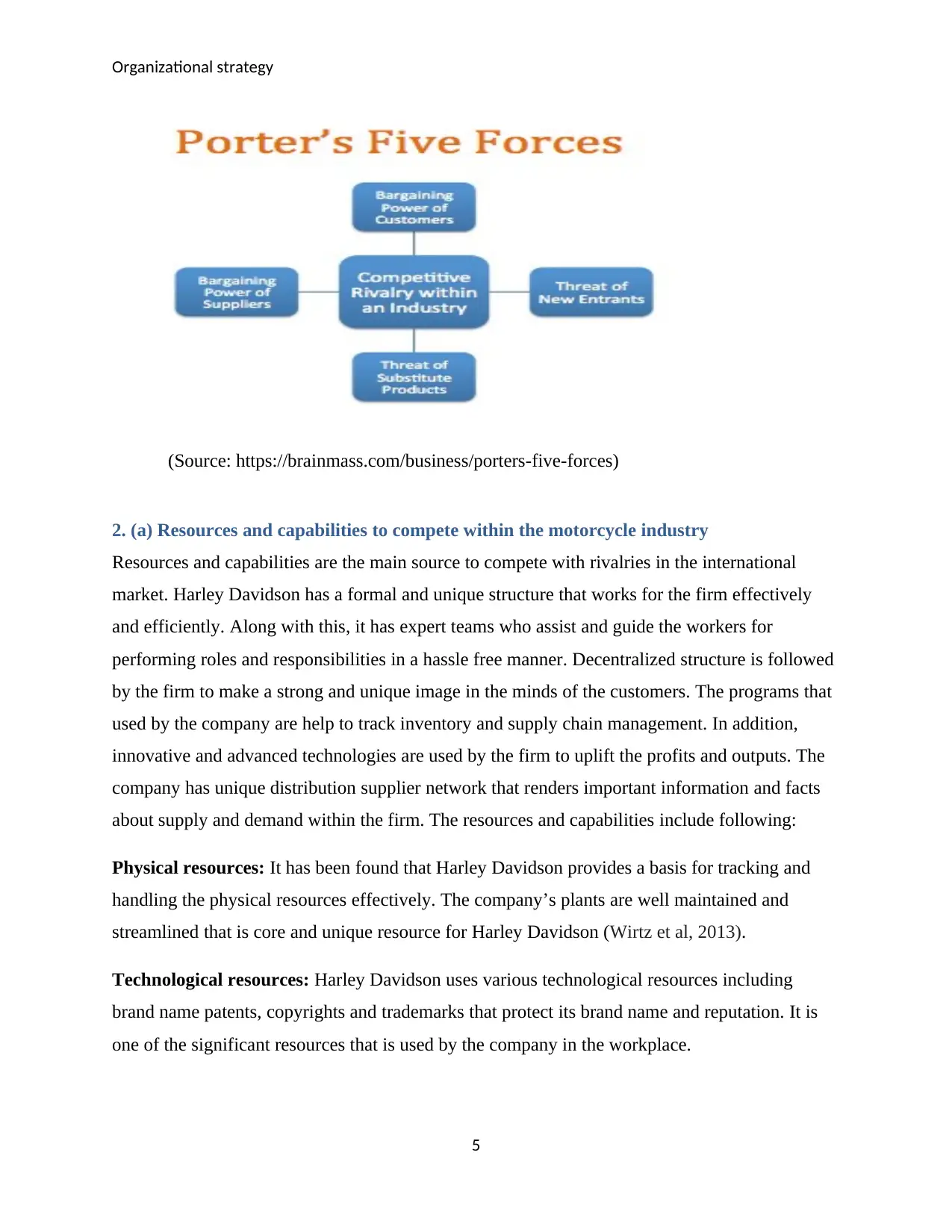
Organizational strategy
(Source: https://brainmass.com/business/porters-five-forces)
2. (a) Resources and capabilities to compete within the motorcycle industry
Resources and capabilities are the main source to compete with rivalries in the international
market. Harley Davidson has a formal and unique structure that works for the firm effectively
and efficiently. Along with this, it has expert teams who assist and guide the workers for
performing roles and responsibilities in a hassle free manner. Decentralized structure is followed
by the firm to make a strong and unique image in the minds of the customers. The programs that
used by the company are help to track inventory and supply chain management. In addition,
innovative and advanced technologies are used by the firm to uplift the profits and outputs. The
company has unique distribution supplier network that renders important information and facts
about supply and demand within the firm. The resources and capabilities include following:
Physical resources: It has been found that Harley Davidson provides a basis for tracking and
handling the physical resources effectively. The company’s plants are well maintained and
streamlined that is core and unique resource for Harley Davidson (Wirtz et al, 2013).
Technological resources: Harley Davidson uses various technological resources including
brand name patents, copyrights and trademarks that protect its brand name and reputation. It is
one of the significant resources that is used by the company in the workplace.
5
(Source: https://brainmass.com/business/porters-five-forces)
2. (a) Resources and capabilities to compete within the motorcycle industry
Resources and capabilities are the main source to compete with rivalries in the international
market. Harley Davidson has a formal and unique structure that works for the firm effectively
and efficiently. Along with this, it has expert teams who assist and guide the workers for
performing roles and responsibilities in a hassle free manner. Decentralized structure is followed
by the firm to make a strong and unique image in the minds of the customers. The programs that
used by the company are help to track inventory and supply chain management. In addition,
innovative and advanced technologies are used by the firm to uplift the profits and outputs. The
company has unique distribution supplier network that renders important information and facts
about supply and demand within the firm. The resources and capabilities include following:
Physical resources: It has been found that Harley Davidson provides a basis for tracking and
handling the physical resources effectively. The company’s plants are well maintained and
streamlined that is core and unique resource for Harley Davidson (Wirtz et al, 2013).
Technological resources: Harley Davidson uses various technological resources including
brand name patents, copyrights and trademarks that protect its brand name and reputation. It is
one of the significant resources that is used by the company in the workplace.
5
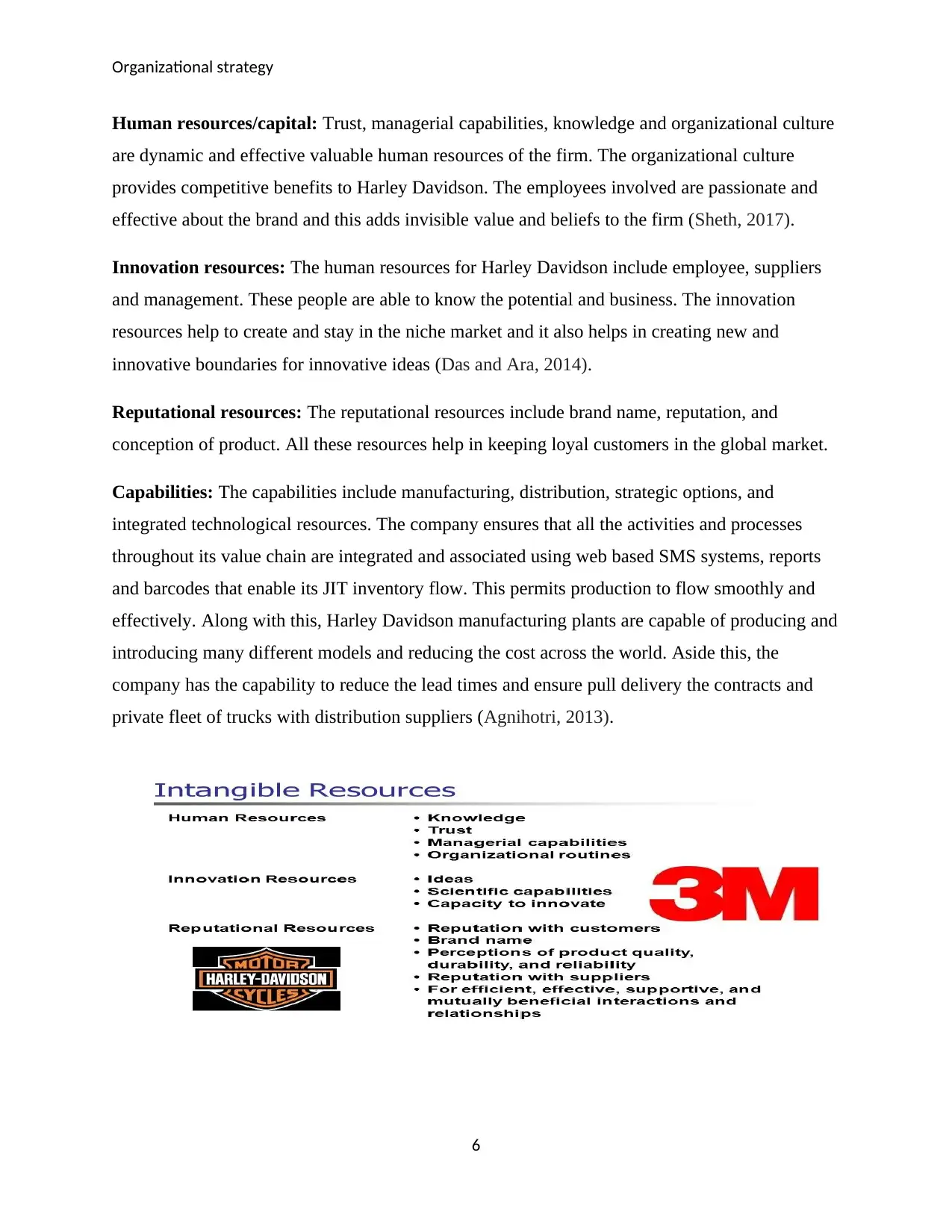
Organizational strategy
Human resources/capital: Trust, managerial capabilities, knowledge and organizational culture
are dynamic and effective valuable human resources of the firm. The organizational culture
provides competitive benefits to Harley Davidson. The employees involved are passionate and
effective about the brand and this adds invisible value and beliefs to the firm (Sheth, 2017).
Innovation resources: The human resources for Harley Davidson include employee, suppliers
and management. These people are able to know the potential and business. The innovation
resources help to create and stay in the niche market and it also helps in creating new and
innovative boundaries for innovative ideas (Das and Ara, 2014).
Reputational resources: The reputational resources include brand name, reputation, and
conception of product. All these resources help in keeping loyal customers in the global market.
Capabilities: The capabilities include manufacturing, distribution, strategic options, and
integrated technological resources. The company ensures that all the activities and processes
throughout its value chain are integrated and associated using web based SMS systems, reports
and barcodes that enable its JIT inventory flow. This permits production to flow smoothly and
effectively. Along with this, Harley Davidson manufacturing plants are capable of producing and
introducing many different models and reducing the cost across the world. Aside this, the
company has the capability to reduce the lead times and ensure pull delivery the contracts and
private fleet of trucks with distribution suppliers (Agnihotri, 2013).
6
Human resources/capital: Trust, managerial capabilities, knowledge and organizational culture
are dynamic and effective valuable human resources of the firm. The organizational culture
provides competitive benefits to Harley Davidson. The employees involved are passionate and
effective about the brand and this adds invisible value and beliefs to the firm (Sheth, 2017).
Innovation resources: The human resources for Harley Davidson include employee, suppliers
and management. These people are able to know the potential and business. The innovation
resources help to create and stay in the niche market and it also helps in creating new and
innovative boundaries for innovative ideas (Das and Ara, 2014).
Reputational resources: The reputational resources include brand name, reputation, and
conception of product. All these resources help in keeping loyal customers in the global market.
Capabilities: The capabilities include manufacturing, distribution, strategic options, and
integrated technological resources. The company ensures that all the activities and processes
throughout its value chain are integrated and associated using web based SMS systems, reports
and barcodes that enable its JIT inventory flow. This permits production to flow smoothly and
effectively. Along with this, Harley Davidson manufacturing plants are capable of producing and
introducing many different models and reducing the cost across the world. Aside this, the
company has the capability to reduce the lead times and ensure pull delivery the contracts and
private fleet of trucks with distribution suppliers (Agnihotri, 2013).
6
⊘ This is a preview!⊘
Do you want full access?
Subscribe today to unlock all pages.

Trusted by 1+ million students worldwide
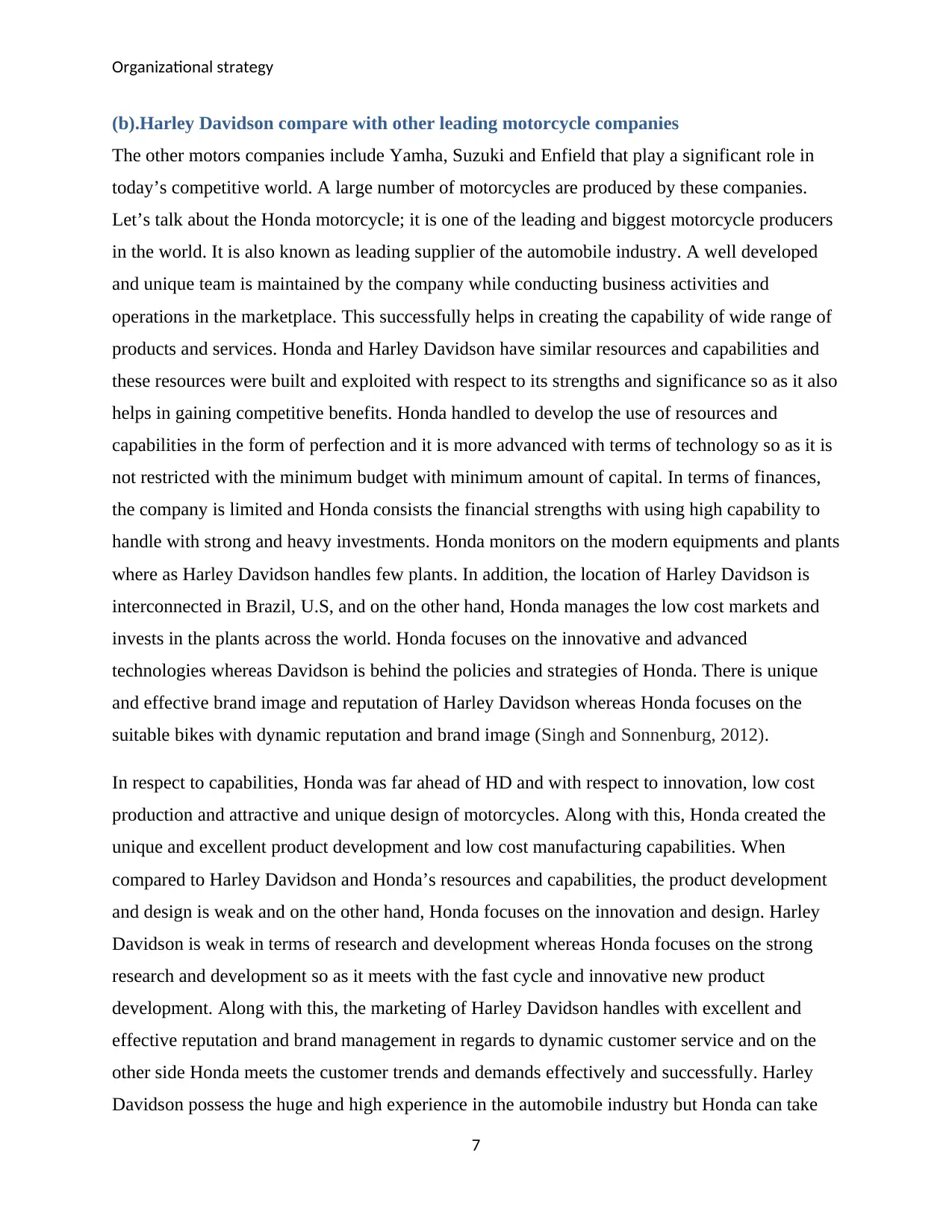
Organizational strategy
(b).Harley Davidson compare with other leading motorcycle companies
The other motors companies include Yamha, Suzuki and Enfield that play a significant role in
today’s competitive world. A large number of motorcycles are produced by these companies.
Let’s talk about the Honda motorcycle; it is one of the leading and biggest motorcycle producers
in the world. It is also known as leading supplier of the automobile industry. A well developed
and unique team is maintained by the company while conducting business activities and
operations in the marketplace. This successfully helps in creating the capability of wide range of
products and services. Honda and Harley Davidson have similar resources and capabilities and
these resources were built and exploited with respect to its strengths and significance so as it also
helps in gaining competitive benefits. Honda handled to develop the use of resources and
capabilities in the form of perfection and it is more advanced with terms of technology so as it is
not restricted with the minimum budget with minimum amount of capital. In terms of finances,
the company is limited and Honda consists the financial strengths with using high capability to
handle with strong and heavy investments. Honda monitors on the modern equipments and plants
where as Harley Davidson handles few plants. In addition, the location of Harley Davidson is
interconnected in Brazil, U.S, and on the other hand, Honda manages the low cost markets and
invests in the plants across the world. Honda focuses on the innovative and advanced
technologies whereas Davidson is behind the policies and strategies of Honda. There is unique
and effective brand image and reputation of Harley Davidson whereas Honda focuses on the
suitable bikes with dynamic reputation and brand image (Singh and Sonnenburg, 2012).
In respect to capabilities, Honda was far ahead of HD and with respect to innovation, low cost
production and attractive and unique design of motorcycles. Along with this, Honda created the
unique and excellent product development and low cost manufacturing capabilities. When
compared to Harley Davidson and Honda’s resources and capabilities, the product development
and design is weak and on the other hand, Honda focuses on the innovation and design. Harley
Davidson is weak in terms of research and development whereas Honda focuses on the strong
research and development so as it meets with the fast cycle and innovative new product
development. Along with this, the marketing of Harley Davidson handles with excellent and
effective reputation and brand management in regards to dynamic customer service and on the
other side Honda meets the customer trends and demands effectively and successfully. Harley
Davidson possess the huge and high experience in the automobile industry but Honda can take
7
(b).Harley Davidson compare with other leading motorcycle companies
The other motors companies include Yamha, Suzuki and Enfield that play a significant role in
today’s competitive world. A large number of motorcycles are produced by these companies.
Let’s talk about the Honda motorcycle; it is one of the leading and biggest motorcycle producers
in the world. It is also known as leading supplier of the automobile industry. A well developed
and unique team is maintained by the company while conducting business activities and
operations in the marketplace. This successfully helps in creating the capability of wide range of
products and services. Honda and Harley Davidson have similar resources and capabilities and
these resources were built and exploited with respect to its strengths and significance so as it also
helps in gaining competitive benefits. Honda handled to develop the use of resources and
capabilities in the form of perfection and it is more advanced with terms of technology so as it is
not restricted with the minimum budget with minimum amount of capital. In terms of finances,
the company is limited and Honda consists the financial strengths with using high capability to
handle with strong and heavy investments. Honda monitors on the modern equipments and plants
where as Harley Davidson handles few plants. In addition, the location of Harley Davidson is
interconnected in Brazil, U.S, and on the other hand, Honda manages the low cost markets and
invests in the plants across the world. Honda focuses on the innovative and advanced
technologies whereas Davidson is behind the policies and strategies of Honda. There is unique
and effective brand image and reputation of Harley Davidson whereas Honda focuses on the
suitable bikes with dynamic reputation and brand image (Singh and Sonnenburg, 2012).
In respect to capabilities, Honda was far ahead of HD and with respect to innovation, low cost
production and attractive and unique design of motorcycles. Along with this, Honda created the
unique and excellent product development and low cost manufacturing capabilities. When
compared to Harley Davidson and Honda’s resources and capabilities, the product development
and design is weak and on the other hand, Honda focuses on the innovation and design. Harley
Davidson is weak in terms of research and development whereas Honda focuses on the strong
research and development so as it meets with the fast cycle and innovative new product
development. Along with this, the marketing of Harley Davidson handles with excellent and
effective reputation and brand management in regards to dynamic customer service and on the
other side Honda meets the customer trends and demands effectively and successfully. Harley
Davidson possess the huge and high experience in the automobile industry but Honda can take
7
Paraphrase This Document
Need a fresh take? Get an instant paraphrase of this document with our AI Paraphraser
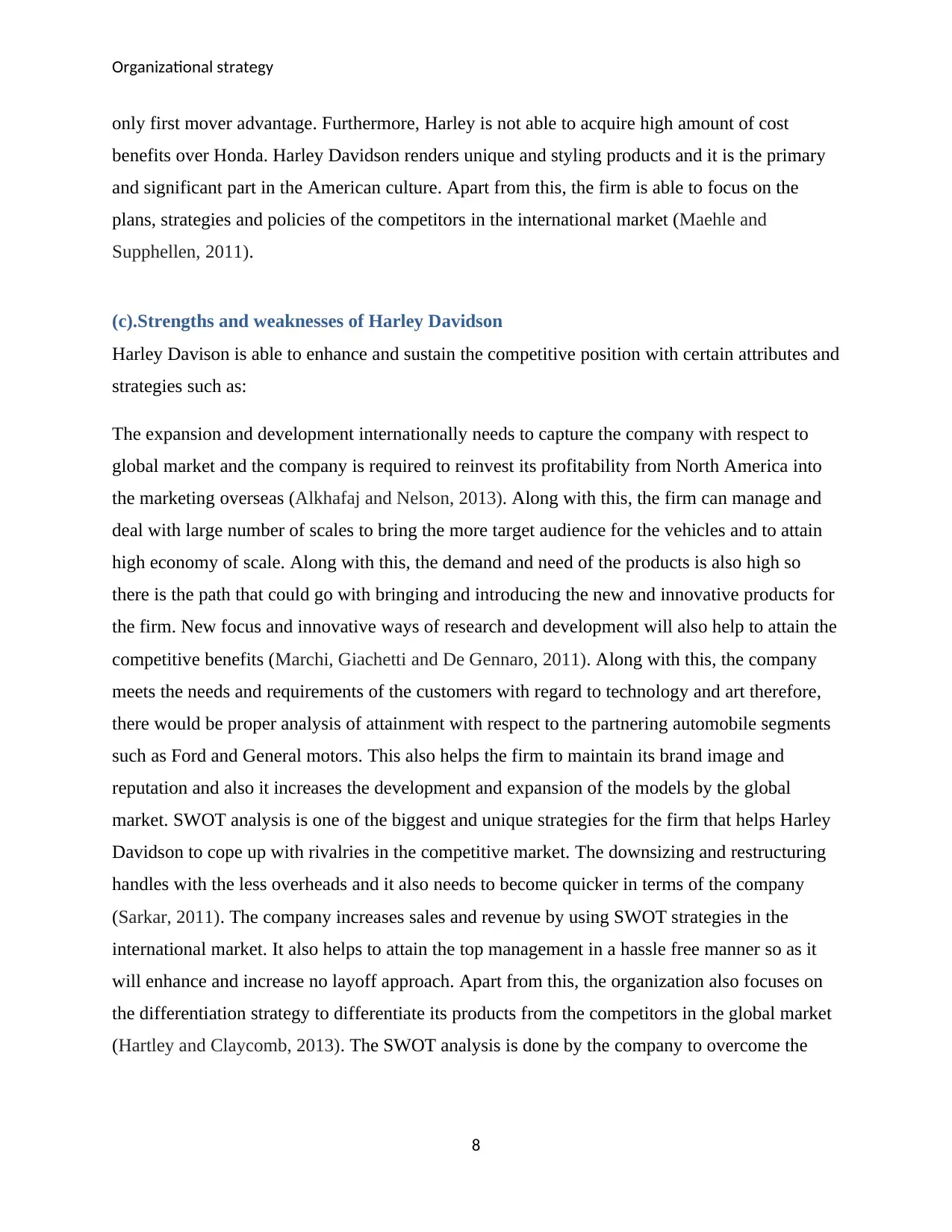
Organizational strategy
only first mover advantage. Furthermore, Harley is not able to acquire high amount of cost
benefits over Honda. Harley Davidson renders unique and styling products and it is the primary
and significant part in the American culture. Apart from this, the firm is able to focus on the
plans, strategies and policies of the competitors in the international market (Maehle and
Supphellen, 2011).
(c).Strengths and weaknesses of Harley Davidson
Harley Davison is able to enhance and sustain the competitive position with certain attributes and
strategies such as:
The expansion and development internationally needs to capture the company with respect to
global market and the company is required to reinvest its profitability from North America into
the marketing overseas (Alkhafaj and Nelson, 2013). Along with this, the firm can manage and
deal with large number of scales to bring the more target audience for the vehicles and to attain
high economy of scale. Along with this, the demand and need of the products is also high so
there is the path that could go with bringing and introducing the new and innovative products for
the firm. New focus and innovative ways of research and development will also help to attain the
competitive benefits (Marchi, Giachetti and De Gennaro, 2011). Along with this, the company
meets the needs and requirements of the customers with regard to technology and art therefore,
there would be proper analysis of attainment with respect to the partnering automobile segments
such as Ford and General motors. This also helps the firm to maintain its brand image and
reputation and also it increases the development and expansion of the models by the global
market. SWOT analysis is one of the biggest and unique strategies for the firm that helps Harley
Davidson to cope up with rivalries in the competitive market. The downsizing and restructuring
handles with the less overheads and it also needs to become quicker in terms of the company
(Sarkar, 2011). The company increases sales and revenue by using SWOT strategies in the
international market. It also helps to attain the top management in a hassle free manner so as it
will enhance and increase no layoff approach. Apart from this, the organization also focuses on
the differentiation strategy to differentiate its products from the competitors in the global market
(Hartley and Claycomb, 2013). The SWOT analysis is done by the company to overcome the
8
only first mover advantage. Furthermore, Harley is not able to acquire high amount of cost
benefits over Honda. Harley Davidson renders unique and styling products and it is the primary
and significant part in the American culture. Apart from this, the firm is able to focus on the
plans, strategies and policies of the competitors in the international market (Maehle and
Supphellen, 2011).
(c).Strengths and weaknesses of Harley Davidson
Harley Davison is able to enhance and sustain the competitive position with certain attributes and
strategies such as:
The expansion and development internationally needs to capture the company with respect to
global market and the company is required to reinvest its profitability from North America into
the marketing overseas (Alkhafaj and Nelson, 2013). Along with this, the firm can manage and
deal with large number of scales to bring the more target audience for the vehicles and to attain
high economy of scale. Along with this, the demand and need of the products is also high so
there is the path that could go with bringing and introducing the new and innovative products for
the firm. New focus and innovative ways of research and development will also help to attain the
competitive benefits (Marchi, Giachetti and De Gennaro, 2011). Along with this, the company
meets the needs and requirements of the customers with regard to technology and art therefore,
there would be proper analysis of attainment with respect to the partnering automobile segments
such as Ford and General motors. This also helps the firm to maintain its brand image and
reputation and also it increases the development and expansion of the models by the global
market. SWOT analysis is one of the biggest and unique strategies for the firm that helps Harley
Davidson to cope up with rivalries in the competitive market. The downsizing and restructuring
handles with the less overheads and it also needs to become quicker in terms of the company
(Sarkar, 2011). The company increases sales and revenue by using SWOT strategies in the
international market. It also helps to attain the top management in a hassle free manner so as it
will enhance and increase no layoff approach. Apart from this, the organization also focuses on
the differentiation strategy to differentiate its products from the competitors in the global market
(Hartley and Claycomb, 2013). The SWOT analysis is done by the company to overcome the
8
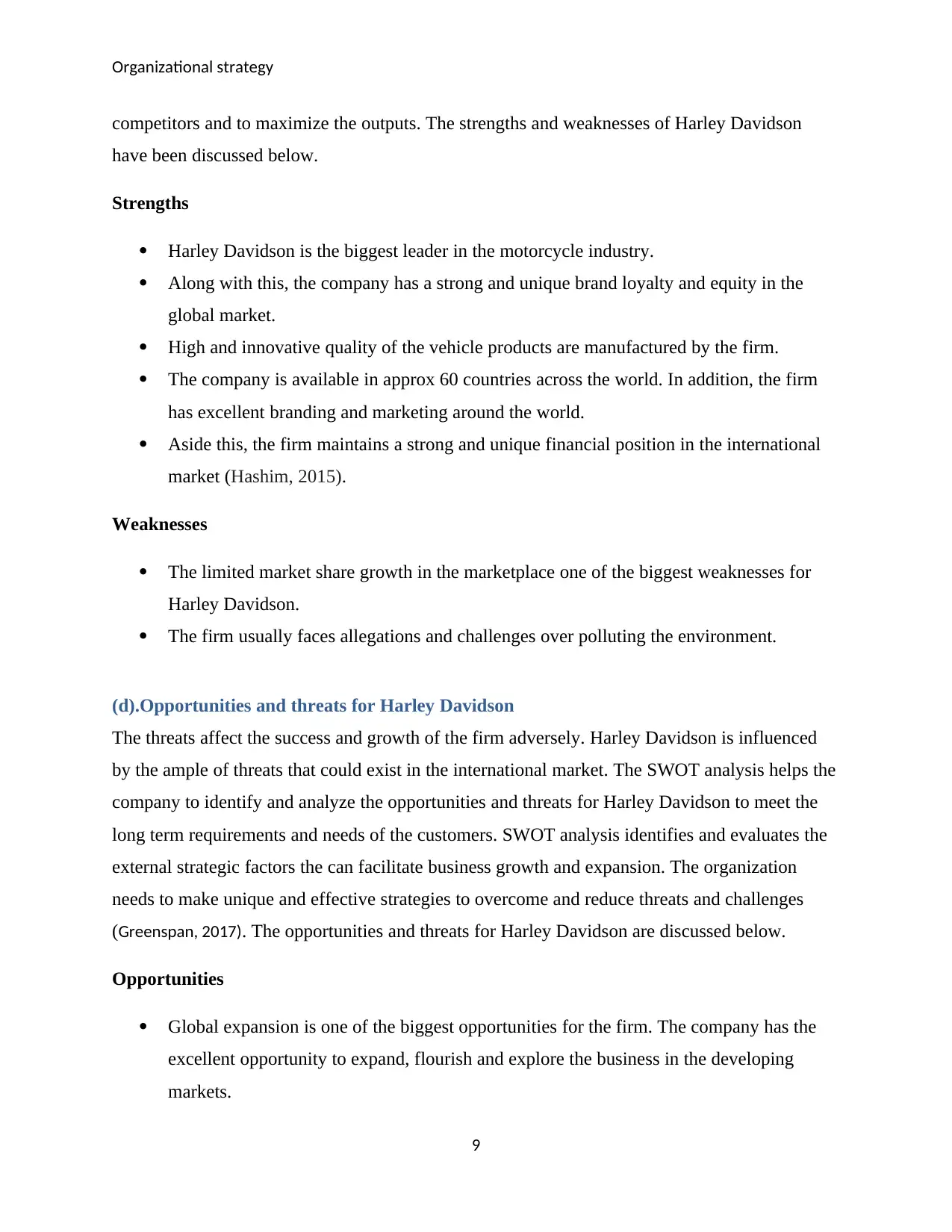
Organizational strategy
competitors and to maximize the outputs. The strengths and weaknesses of Harley Davidson
have been discussed below.
Strengths
Harley Davidson is the biggest leader in the motorcycle industry.
Along with this, the company has a strong and unique brand loyalty and equity in the
global market.
High and innovative quality of the vehicle products are manufactured by the firm.
The company is available in approx 60 countries across the world. In addition, the firm
has excellent branding and marketing around the world.
Aside this, the firm maintains a strong and unique financial position in the international
market (Hashim, 2015).
Weaknesses
The limited market share growth in the marketplace one of the biggest weaknesses for
Harley Davidson.
The firm usually faces allegations and challenges over polluting the environment.
(d).Opportunities and threats for Harley Davidson
The threats affect the success and growth of the firm adversely. Harley Davidson is influenced
by the ample of threats that could exist in the international market. The SWOT analysis helps the
company to identify and analyze the opportunities and threats for Harley Davidson to meet the
long term requirements and needs of the customers. SWOT analysis identifies and evaluates the
external strategic factors the can facilitate business growth and expansion. The organization
needs to make unique and effective strategies to overcome and reduce threats and challenges
(Greenspan, 2017). The opportunities and threats for Harley Davidson are discussed below.
Opportunities
Global expansion is one of the biggest opportunities for the firm. The company has the
excellent opportunity to expand, flourish and explore the business in the developing
markets.
9
competitors and to maximize the outputs. The strengths and weaknesses of Harley Davidson
have been discussed below.
Strengths
Harley Davidson is the biggest leader in the motorcycle industry.
Along with this, the company has a strong and unique brand loyalty and equity in the
global market.
High and innovative quality of the vehicle products are manufactured by the firm.
The company is available in approx 60 countries across the world. In addition, the firm
has excellent branding and marketing around the world.
Aside this, the firm maintains a strong and unique financial position in the international
market (Hashim, 2015).
Weaknesses
The limited market share growth in the marketplace one of the biggest weaknesses for
Harley Davidson.
The firm usually faces allegations and challenges over polluting the environment.
(d).Opportunities and threats for Harley Davidson
The threats affect the success and growth of the firm adversely. Harley Davidson is influenced
by the ample of threats that could exist in the international market. The SWOT analysis helps the
company to identify and analyze the opportunities and threats for Harley Davidson to meet the
long term requirements and needs of the customers. SWOT analysis identifies and evaluates the
external strategic factors the can facilitate business growth and expansion. The organization
needs to make unique and effective strategies to overcome and reduce threats and challenges
(Greenspan, 2017). The opportunities and threats for Harley Davidson are discussed below.
Opportunities
Global expansion is one of the biggest opportunities for the firm. The company has the
excellent opportunity to expand, flourish and explore the business in the developing
markets.
9
⊘ This is a preview!⊘
Do you want full access?
Subscribe today to unlock all pages.

Trusted by 1+ million students worldwide
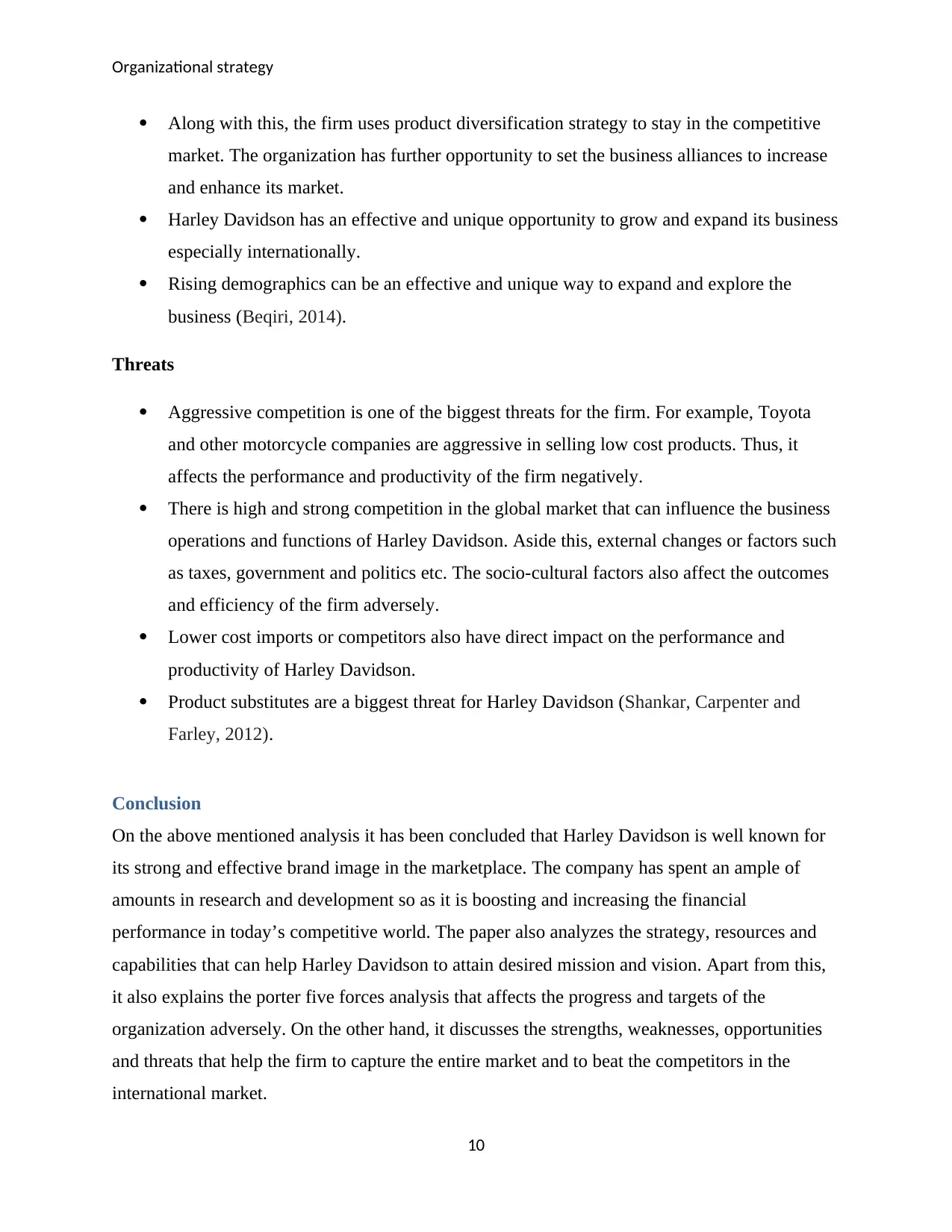
Organizational strategy
Along with this, the firm uses product diversification strategy to stay in the competitive
market. The organization has further opportunity to set the business alliances to increase
and enhance its market.
Harley Davidson has an effective and unique opportunity to grow and expand its business
especially internationally.
Rising demographics can be an effective and unique way to expand and explore the
business (Beqiri, 2014).
Threats
Aggressive competition is one of the biggest threats for the firm. For example, Toyota
and other motorcycle companies are aggressive in selling low cost products. Thus, it
affects the performance and productivity of the firm negatively.
There is high and strong competition in the global market that can influence the business
operations and functions of Harley Davidson. Aside this, external changes or factors such
as taxes, government and politics etc. The socio-cultural factors also affect the outcomes
and efficiency of the firm adversely.
Lower cost imports or competitors also have direct impact on the performance and
productivity of Harley Davidson.
Product substitutes are a biggest threat for Harley Davidson (Shankar, Carpenter and
Farley, 2012).
Conclusion
On the above mentioned analysis it has been concluded that Harley Davidson is well known for
its strong and effective brand image in the marketplace. The company has spent an ample of
amounts in research and development so as it is boosting and increasing the financial
performance in today’s competitive world. The paper also analyzes the strategy, resources and
capabilities that can help Harley Davidson to attain desired mission and vision. Apart from this,
it also explains the porter five forces analysis that affects the progress and targets of the
organization adversely. On the other hand, it discusses the strengths, weaknesses, opportunities
and threats that help the firm to capture the entire market and to beat the competitors in the
international market.
10
Along with this, the firm uses product diversification strategy to stay in the competitive
market. The organization has further opportunity to set the business alliances to increase
and enhance its market.
Harley Davidson has an effective and unique opportunity to grow and expand its business
especially internationally.
Rising demographics can be an effective and unique way to expand and explore the
business (Beqiri, 2014).
Threats
Aggressive competition is one of the biggest threats for the firm. For example, Toyota
and other motorcycle companies are aggressive in selling low cost products. Thus, it
affects the performance and productivity of the firm negatively.
There is high and strong competition in the global market that can influence the business
operations and functions of Harley Davidson. Aside this, external changes or factors such
as taxes, government and politics etc. The socio-cultural factors also affect the outcomes
and efficiency of the firm adversely.
Lower cost imports or competitors also have direct impact on the performance and
productivity of Harley Davidson.
Product substitutes are a biggest threat for Harley Davidson (Shankar, Carpenter and
Farley, 2012).
Conclusion
On the above mentioned analysis it has been concluded that Harley Davidson is well known for
its strong and effective brand image in the marketplace. The company has spent an ample of
amounts in research and development so as it is boosting and increasing the financial
performance in today’s competitive world. The paper also analyzes the strategy, resources and
capabilities that can help Harley Davidson to attain desired mission and vision. Apart from this,
it also explains the porter five forces analysis that affects the progress and targets of the
organization adversely. On the other hand, it discusses the strengths, weaknesses, opportunities
and threats that help the firm to capture the entire market and to beat the competitors in the
international market.
10
Paraphrase This Document
Need a fresh take? Get an instant paraphrase of this document with our AI Paraphraser
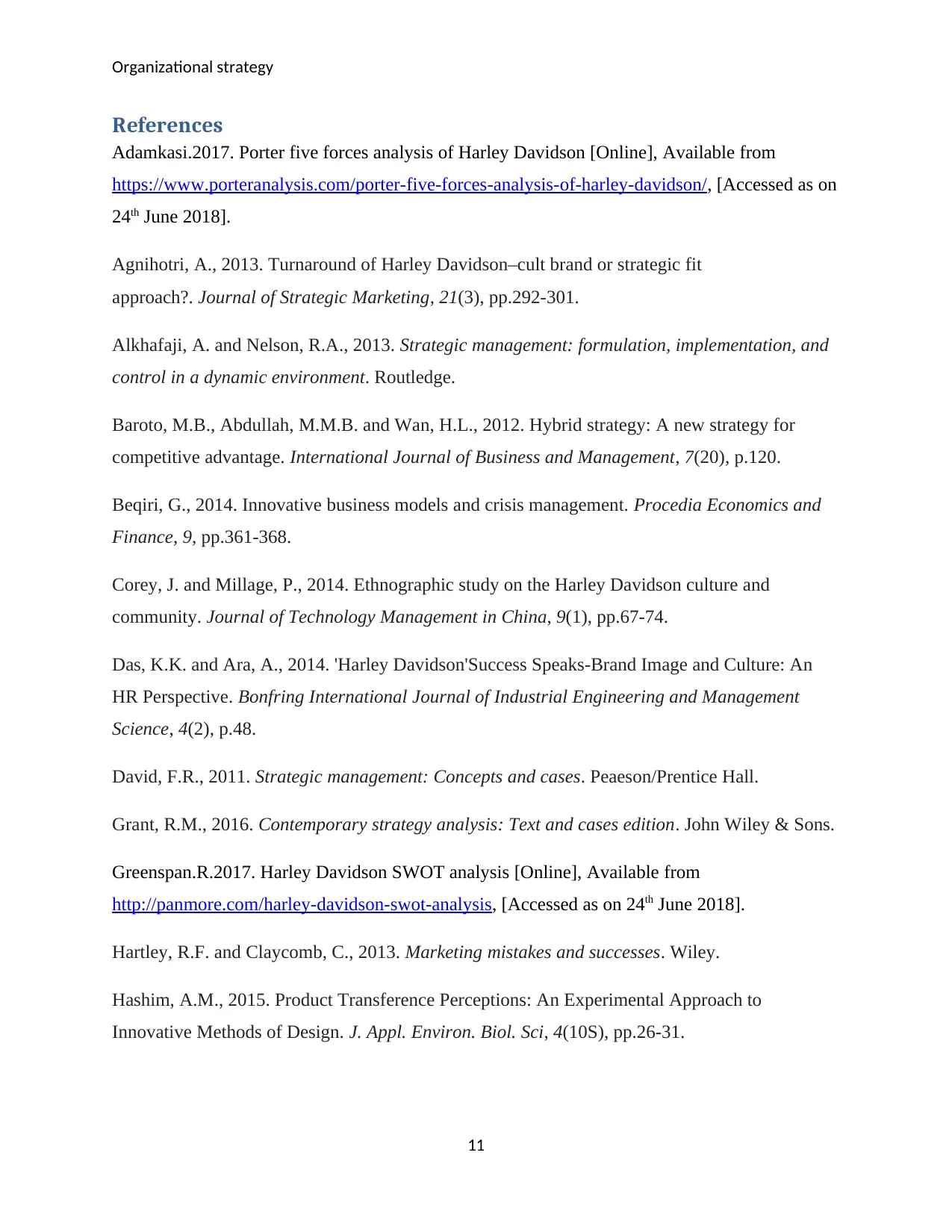
Organizational strategy
References
Adamkasi.2017. Porter five forces analysis of Harley Davidson [Online], Available from
https://www.porteranalysis.com/porter-five-forces-analysis-of-harley-davidson/, [Accessed as on
24th June 2018].
Agnihotri, A., 2013. Turnaround of Harley Davidson–cult brand or strategic fit
approach?. Journal of Strategic Marketing, 21(3), pp.292-301.
Alkhafaji, A. and Nelson, R.A., 2013. Strategic management: formulation, implementation, and
control in a dynamic environment. Routledge.
Baroto, M.B., Abdullah, M.M.B. and Wan, H.L., 2012. Hybrid strategy: A new strategy for
competitive advantage. International Journal of Business and Management, 7(20), p.120.
Beqiri, G., 2014. Innovative business models and crisis management. Procedia Economics and
Finance, 9, pp.361-368.
Corey, J. and Millage, P., 2014. Ethnographic study on the Harley Davidson culture and
community. Journal of Technology Management in China, 9(1), pp.67-74.
Das, K.K. and Ara, A., 2014. 'Harley Davidson'Success Speaks-Brand Image and Culture: An
HR Perspective. Bonfring International Journal of Industrial Engineering and Management
Science, 4(2), p.48.
David, F.R., 2011. Strategic management: Concepts and cases. Peaeson/Prentice Hall.
Grant, R.M., 2016. Contemporary strategy analysis: Text and cases edition. John Wiley & Sons.
Greenspan.R.2017. Harley Davidson SWOT analysis [Online], Available from
http://panmore.com/harley-davidson-swot-analysis, [Accessed as on 24th June 2018].
Hartley, R.F. and Claycomb, C., 2013. Marketing mistakes and successes. Wiley.
Hashim, A.M., 2015. Product Transference Perceptions: An Experimental Approach to
Innovative Methods of Design. J. Appl. Environ. Biol. Sci, 4(10S), pp.26-31.
11
References
Adamkasi.2017. Porter five forces analysis of Harley Davidson [Online], Available from
https://www.porteranalysis.com/porter-five-forces-analysis-of-harley-davidson/, [Accessed as on
24th June 2018].
Agnihotri, A., 2013. Turnaround of Harley Davidson–cult brand or strategic fit
approach?. Journal of Strategic Marketing, 21(3), pp.292-301.
Alkhafaji, A. and Nelson, R.A., 2013. Strategic management: formulation, implementation, and
control in a dynamic environment. Routledge.
Baroto, M.B., Abdullah, M.M.B. and Wan, H.L., 2012. Hybrid strategy: A new strategy for
competitive advantage. International Journal of Business and Management, 7(20), p.120.
Beqiri, G., 2014. Innovative business models and crisis management. Procedia Economics and
Finance, 9, pp.361-368.
Corey, J. and Millage, P., 2014. Ethnographic study on the Harley Davidson culture and
community. Journal of Technology Management in China, 9(1), pp.67-74.
Das, K.K. and Ara, A., 2014. 'Harley Davidson'Success Speaks-Brand Image and Culture: An
HR Perspective. Bonfring International Journal of Industrial Engineering and Management
Science, 4(2), p.48.
David, F.R., 2011. Strategic management: Concepts and cases. Peaeson/Prentice Hall.
Grant, R.M., 2016. Contemporary strategy analysis: Text and cases edition. John Wiley & Sons.
Greenspan.R.2017. Harley Davidson SWOT analysis [Online], Available from
http://panmore.com/harley-davidson-swot-analysis, [Accessed as on 24th June 2018].
Hartley, R.F. and Claycomb, C., 2013. Marketing mistakes and successes. Wiley.
Hashim, A.M., 2015. Product Transference Perceptions: An Experimental Approach to
Innovative Methods of Design. J. Appl. Environ. Biol. Sci, 4(10S), pp.26-31.
11
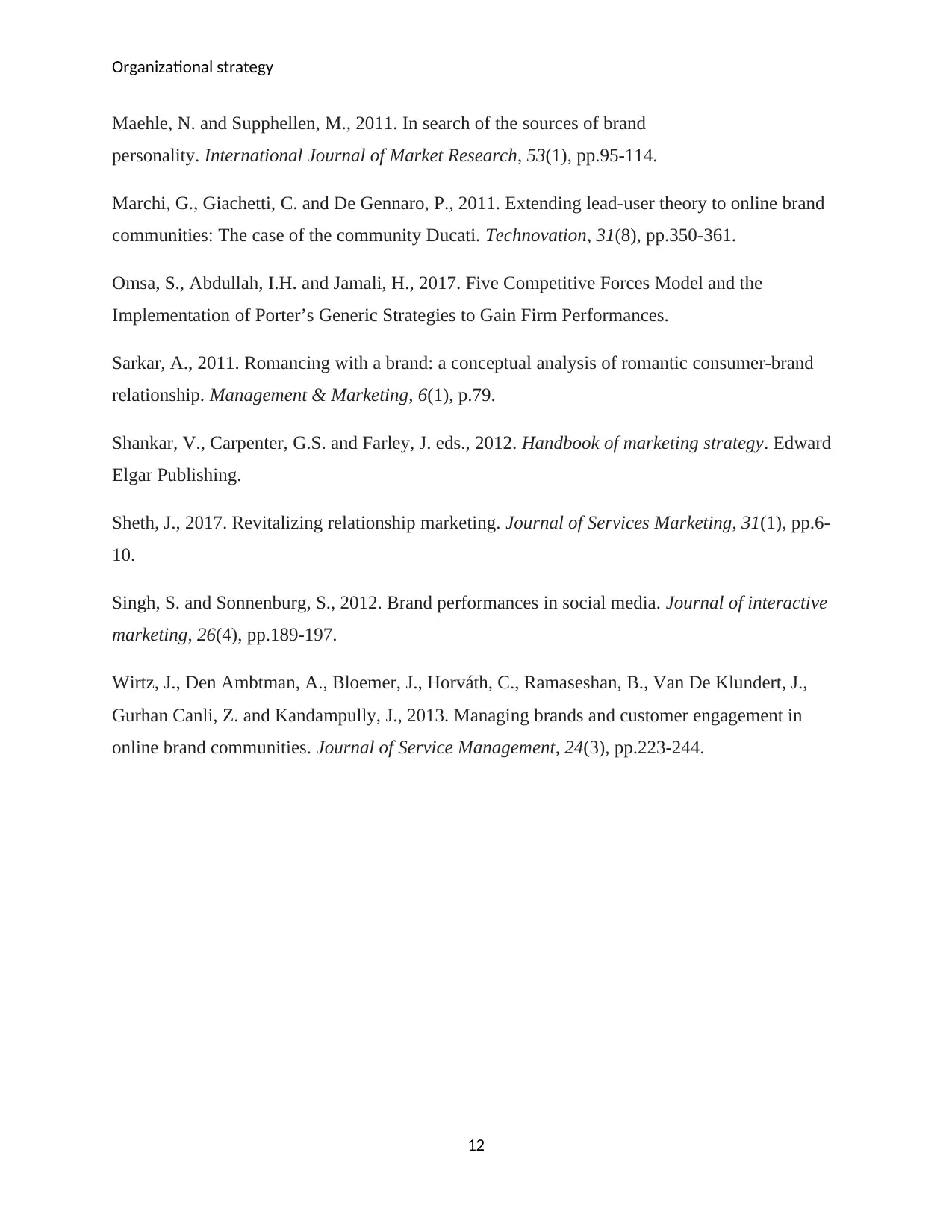
Organizational strategy
Maehle, N. and Supphellen, M., 2011. In search of the sources of brand
personality. International Journal of Market Research, 53(1), pp.95-114.
Marchi, G., Giachetti, C. and De Gennaro, P., 2011. Extending lead-user theory to online brand
communities: The case of the community Ducati. Technovation, 31(8), pp.350-361.
Omsa, S., Abdullah, I.H. and Jamali, H., 2017. Five Competitive Forces Model and the
Implementation of Porter’s Generic Strategies to Gain Firm Performances.
Sarkar, A., 2011. Romancing with a brand: a conceptual analysis of romantic consumer-brand
relationship. Management & Marketing, 6(1), p.79.
Shankar, V., Carpenter, G.S. and Farley, J. eds., 2012. Handbook of marketing strategy. Edward
Elgar Publishing.
Sheth, J., 2017. Revitalizing relationship marketing. Journal of Services Marketing, 31(1), pp.6-
10.
Singh, S. and Sonnenburg, S., 2012. Brand performances in social media. Journal of interactive
marketing, 26(4), pp.189-197.
Wirtz, J., Den Ambtman, A., Bloemer, J., Horváth, C., Ramaseshan, B., Van De Klundert, J.,
Gurhan Canli, Z. and Kandampully, J., 2013. Managing brands and customer engagement in
online brand communities. Journal of Service Management, 24(3), pp.223-244.
12
Maehle, N. and Supphellen, M., 2011. In search of the sources of brand
personality. International Journal of Market Research, 53(1), pp.95-114.
Marchi, G., Giachetti, C. and De Gennaro, P., 2011. Extending lead-user theory to online brand
communities: The case of the community Ducati. Technovation, 31(8), pp.350-361.
Omsa, S., Abdullah, I.H. and Jamali, H., 2017. Five Competitive Forces Model and the
Implementation of Porter’s Generic Strategies to Gain Firm Performances.
Sarkar, A., 2011. Romancing with a brand: a conceptual analysis of romantic consumer-brand
relationship. Management & Marketing, 6(1), p.79.
Shankar, V., Carpenter, G.S. and Farley, J. eds., 2012. Handbook of marketing strategy. Edward
Elgar Publishing.
Sheth, J., 2017. Revitalizing relationship marketing. Journal of Services Marketing, 31(1), pp.6-
10.
Singh, S. and Sonnenburg, S., 2012. Brand performances in social media. Journal of interactive
marketing, 26(4), pp.189-197.
Wirtz, J., Den Ambtman, A., Bloemer, J., Horváth, C., Ramaseshan, B., Van De Klundert, J.,
Gurhan Canli, Z. and Kandampully, J., 2013. Managing brands and customer engagement in
online brand communities. Journal of Service Management, 24(3), pp.223-244.
12
⊘ This is a preview!⊘
Do you want full access?
Subscribe today to unlock all pages.

Trusted by 1+ million students worldwide
1 out of 12
Related Documents
Your All-in-One AI-Powered Toolkit for Academic Success.
+13062052269
info@desklib.com
Available 24*7 on WhatsApp / Email
![[object Object]](/_next/static/media/star-bottom.7253800d.svg)
Unlock your academic potential
Copyright © 2020–2025 A2Z Services. All Rights Reserved. Developed and managed by ZUCOL.





